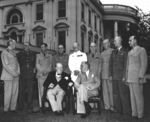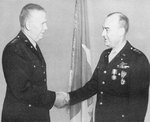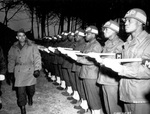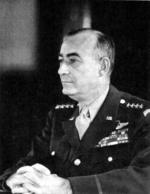Joseph McNarney
| Surname | McNarney |
| Given Name | Joseph |
| Born | 28 Aug 1893 |
| Died | 1 Feb 1972 |
| Country | United States |
| Category | Military-Air |
| Gender | Male |
Contributor: C. Peter Chen
ww2dbaseJoseph Taggart McNarney graduated from the United States Military Academy at West Point, New York, United States in Jun 1915 and was commissioned a junior officer in the infantry. In Jul 1916, at the rank of first lieutenant, he began flight training at San Diego, California, United States. He was transferred to the US Army's Signal Corps Aviation Section in 1917, and shortly after he was promoted to the rank of captain in May 1917. In France, during WW1, he served successively with the 1st Corps Aeronautical School, Headquarters Air Service, 2nd Corps School, 1st Aero Squadron (as commanding officer), 1st Corps Observation Group (as commanding officer), 1st Army (on the staff of the chief of Air Service), and Observation Group of 2nd Army (as commanding officer). He was promoted to the rank of major in Jun 1918, followed by lieutenant colonel in May 1919. Returning to the US in Oct 1919, he was placed in charge of the flight school at Gerstner Field, Louisiana, United States. In Sep 1920, he reverted to his permanent rank of captain. Between Nov 1919 and 1924, he was at Langley Field, Virginia, United States, first as a student than as an instructor of the Air Corps Tactical School. He completed studies at the Command and General Staff School at Fort Leavenworth, Kansas, United States later in mid-1920s, upon which he was assigned to the Air Section of the War Department General Staff. In Aug 1930, he completed studies at the Army War College. Later in the same year, he was made the commanding officer of the Primary Flying School at March Field, California, United States, which later moved to Randolph Field, Texas, United States; while at March Field, he also held the concurrent duty as the commanding officer of the 7th Bomb Group. Between Aug 1933 and Mar 1935, he was an instructor at the Army War College. Starting in Mar 1935, he helped in the organization of the new General Headquarters Air Force. In Jul 1938, he was assigned to Hamilton Field, California, United States. In early 1939, he was assigned to the War Plans Division of the War Department General Staff. In Jun 1939, he was made a member of the Joint Army-Navy Planning Committee. In Mar 1940, he was promoted to the rank of colonel. In May 1940, he was appointed to the American-Canadian Permanent Joint Board on Defense. He was promoted to the rank of brigadier general in Apr 1941, and shortly after he was made the chief of staff of a special Army observer group in London, England, United Kingdom, returning in Dec 1941 after US entered WW2.
ww2dbaseMcNarney's first assignment during WW2 was with the Roberts Commission, which investigated US Army and US Navy commanders for the debacle at Hawaii. In Jan 1942, he was promoted to the rank of major general and was assigned to the War Department Reorganization Board. In Mar 1942, he was promoted to the rank of lieutenant general and was made the deputy chief of staff of the Army; in this role, he helped develop anti-submarine warfare strategies, thus playing a part in the formation of Army Air Forces Antisubmarine Command. In Oct 1944, he was transferred to Europe to serve as Deputy Supreme Allied Commander in the Mediterranean Theater, with command over all US Army forces in the region. He was promoted to the rank of general in Mar 1945.
ww2dbaseAfter the war, McNarney was made the acting supreme allied commander of the Mediterranean Theater in Sep 1945, and then the commanding general of US Forces in the European Theater and Chief of US Forces of Occupation in Germany in Nov 1945. In Mar 1947, he became a member of the United Nations Military Staff Committee, based in New York, New York, United States. In Oct 1947, he was made the commanding general of Air Materiel Command at Wright-Patterson Air Force Base in Ohio, United States. In Sep 1949, he became the chief of the Management Committee of the US Department of Defense. He retired from military service in 1952. As a civilian, he served as an executive with the firm General Dynamics and as a member of US President Dwight Eisenhower's Draper Committee which analyzed military assistance aspects of the US Mutual Security Program. He passed away in 1972.
ww2dbaseSource: Wikipedia
Last Major Revision: Dec 2013
Joseph McNarney Mapa Interativo
Photographs
 |  |  |  |
Joseph McNarney Timeline
| 28 ago 1893 | Joseph McNarney was born in Emporium, Pennsylvania, United States. |
| 12 jun 1911 | Joseph McNarney departed Emporium, Pennsylvania, United States for the United States Military Academy at West Point, New York, United States. |
| 26 ago 1940 | The American-Canadian Permanent Joint Board on Defense convened in Ottawa, Canada. The American attendees were Fiorello H. LaGuardia (President, U.S. Conference of Mayors), Lieutenant General Stanley D. Embick (US Army commander of the Fourth Corps Area), Captain Harry W. Hill, and Commander Forrest P. Sherman (US Navy War Plans Division), Lieutenant Colonel Joseph T. McNarney, and John D. Hickerson (Assistant Chief of Division of European Affairs of the US Department of State). |
| 26 nov 1945 | Joseph McNarney was made the commanding general of US Forces in the European Theater, succeeding Dwight Eisenhower. |
| 15 mar 1947 | Joseph McNarney stepped down as the commanding general of US Forces in the European Theater. |
| 31 jan 1952 | Joseph McNarney retired from military service. |
| 1 fev 1972 | Joseph McNarney passed away in La Jolla, California, United States. |
Você gostou deste artigo ou achou este artigo útil? Se sim, considere nos apoiar no Patreon. Qualquer valor já vai ajudar! Obrigado. Por favor, ajude-nos a divulgar o site: Fique atualizado com WW2DB: |

- » Wreck of Teruzuki Found (27 jul 2025)
- » USS Orlean's Bow Found (22 jul 2025)
- » The Emperor of Japan Planned to Honor WW2-era Japanese POWs in Mongolia (4 jul 2025)
- » US State Lawmaker John Winter Caught Using Racial Slur "Jap" and Apologized (11 jun 2025)
- » US Government Plans to Purge WW2 Information (17 mar 2025)
- » Ver todas as notícias
- » 1,182 biografias
- » 337 eventos
- » 45,119 entradas na linha do tempo
- » 1,249 navios
- » 350 modelos de aeronaves
- » 207 modelos de veículos
- » 376 modelos de armas
- » 123 documentos históricos
- » 261 instalações
- » 470 resenhas de livros
- » 28,412 fotos
- » 365 mapas
Captain Henry P. Jim Crowe, Guadalcanal, 13 Jan 1943
Por favor, considere nos apoiar no Patreon. Mesmo R$1 por mês já faz uma grande diferença. Obrigado!
Ou, por favor, nos apoie adquirindo alguns produtos do WW2DB na TeeSpring. Obrigado!